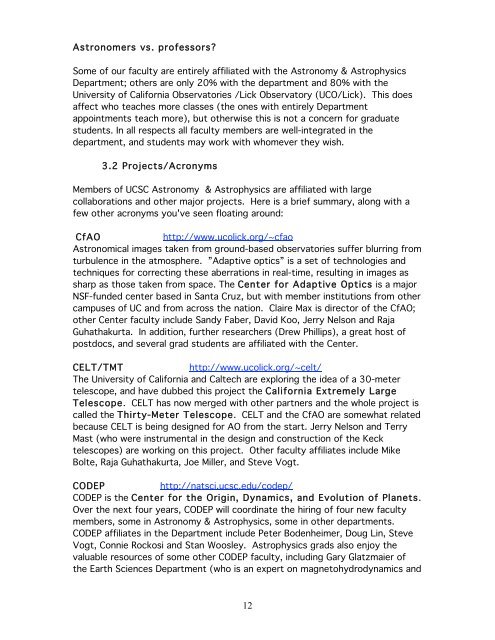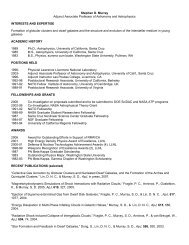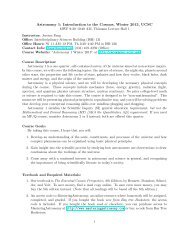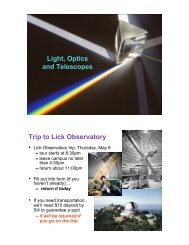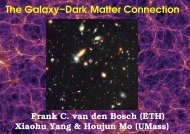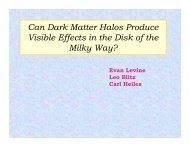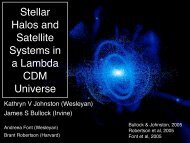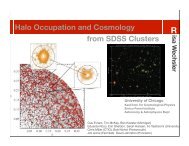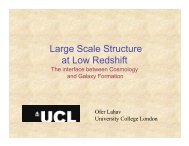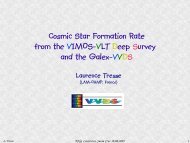UCSC Astronomy & Astrophysics Orientation Guide last update ...
UCSC Astronomy & Astrophysics Orientation Guide last update ...
UCSC Astronomy & Astrophysics Orientation Guide last update ...
You also want an ePaper? Increase the reach of your titles
YUMPU automatically turns print PDFs into web optimized ePapers that Google loves.
Astronomers vs. professors?<br />
Some of our faculty are entirely affiliated with the <strong>Astronomy</strong> & <strong>Astrophysics</strong><br />
Department; others are only 20% with the department and 80% with the<br />
University of California Observatories /Lick Observatory (UCO/Lick). This does<br />
affect who teaches more classes (the ones with entirely Department<br />
appointments teach more), but otherwise this is not a concern for graduate<br />
students. In all respects all faculty members are well-integrated in the<br />
department, and students may work with whomever they wish.<br />
3.2 Projects/Acronyms<br />
Members of <strong>UCSC</strong> <strong>Astronomy</strong> & <strong>Astrophysics</strong> are affiliated with large<br />
collaborations and other major projects. Here is a brief summary, along with a<br />
few other acronyms you've seen floating around:<br />
CfAO http://www.ucolick.org/~cfao<br />
Astronomical images taken from ground-based observatories suffer blurring from<br />
turbulence in the atmosphere. ”Adaptive optics” is a set of technologies and<br />
techniques for correcting these aberrations in real-time, resulting in images as<br />
sharp as those taken from space. The Center for Adaptive Optics is a major<br />
NSF-funded center based in Santa Cruz, but with member institutions from other<br />
campuses of UC and from across the nation. Claire Max is director of the CfAO;<br />
other Center faculty include Sandy Faber, David Koo, Jerry Nelson and Raja<br />
Guhathakurta. In addition, further researchers (Drew Phillips), a great host of<br />
postdocs, and several grad students are affiliated with the Center.<br />
CELT/TMT http://www.ucolick.org/~celt/<br />
The University of California and Caltech are exploring the idea of a 30-meter<br />
telescope, and have dubbed this project the California Extremely Large<br />
Telescope. CELT has now merged with other partners and the whole project is<br />
called the Thirty-Meter Telescope. CELT and the CfAO are somewhat related<br />
because CELT is being designed for AO from the start. Jerry Nelson and Terry<br />
Mast (who were instrumental in the design and construction of the Keck<br />
telescopes) are working on this project. Other faculty affiliates include Mike<br />
Bolte, Raja Guhathakurta, Joe Miller, and Steve Vogt.<br />
CODEP http://natsci.ucsc.edu/codep/<br />
CODEP is the Center for the Origin, Dynamics, and Evolution of Planets.<br />
Over the next four years, CODEP will coordinate the hiring of four new faculty<br />
members, some in <strong>Astronomy</strong> & <strong>Astrophysics</strong>, some in other departments.<br />
CODEP affiliates in the Department include Peter Bodenheimer, Doug Lin, Steve<br />
Vogt, Connie Rockosi and Stan Woosley. <strong>Astrophysics</strong> grads also enjoy the<br />
valuable resources of some other CODEP faculty, including Gary Glatzmaier of<br />
the Earth Sciences Department (who is an expert on magnetohydrodynamics and<br />
12


